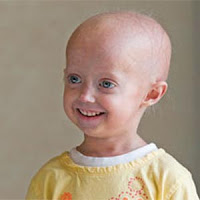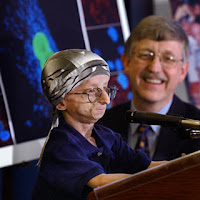The US Trends | Progeria - Hutchinson–Gilford Progeria Syndrome | Progeria (also known as "Hutchinson-Gilford Progeria Syndrome", "Hutchinson-Gilford syndrome," and "Progeria Syndrome") is an extremely rare genetic disease with symptoms that resemble aspects of aging, occurring at an early age. The word progeria is derived from the greek "pro" means "before" and "Geras" means "old age". The disease has a very low incidence and occurs in about 1 in 8 million live births. I was born with progeria typically live their teens and twenties. It is a genetic disease that presents itself as a new mutation (de novo), and is not hereditary. While the term progeria is, strictly speaking, all the diseases characterized by symptoms of premature aging, and is often used as such, is often applied, in particular reference to the syndrome of Hutchinson-Gilford Progeria.
Scientists are particularly interested in progeria because it might reveal clues about the normal process of aging. Progeria was first described in 1886 by Jonathan Hutchinson. It was also described independently in 1897 by Hastings Gilford. The condition was later named Hutchinson-Gilford Progeria Syndrome (HGPS).
The earliest symptoms include failure to thrive and a localized scleroderma-like skin condition. As a child ages past infancy, additional conditions become apparent. Limited growth, alopecia, and a distinctive appearance (small face and jaw, pinched nose) are all characteristics of progeria. People diagnosed with this disorder usually have small, fragile bodies, like those of elderly people. Later, the condition causes wrinkled skin, atherosclerosis, kidney failure, loss of eyesight, hair loss, and cardiovascular problems. It is not transferred by the offspring.
A child with this condition show signs of symptoms is usually around 18-24 months. After birth a healthy baby in the research, its size and weight suddenly, below the average for their age. People generally maintain normal mental and motor development. There are many signs and symptoms of this progressive disease, and tend to worsen as the child grows. The appearance of the face is often wrinkled, with a larger head relative to its body, with a narrow face and beak nose. The child experiences the whole body alopecia. Scleroderma, a hardening and narrowing of the skin on the trunk and limbs of the body, is also widespread. As experience hair loss, scalp veins are visible and prominent bulging eyes. Musculoskeletal degeneration causes loss of body fat and muscle, joint stiffness, hip dislocations, and other symptoms usually absent in non-elderly population. - THE US TRENDS
Progeria - Hutchinson–Gilford Progeria Syndrome











No comments:
Post a Comment